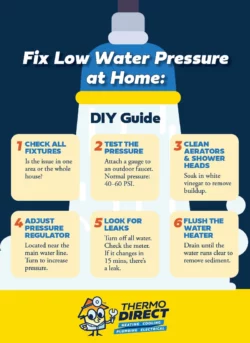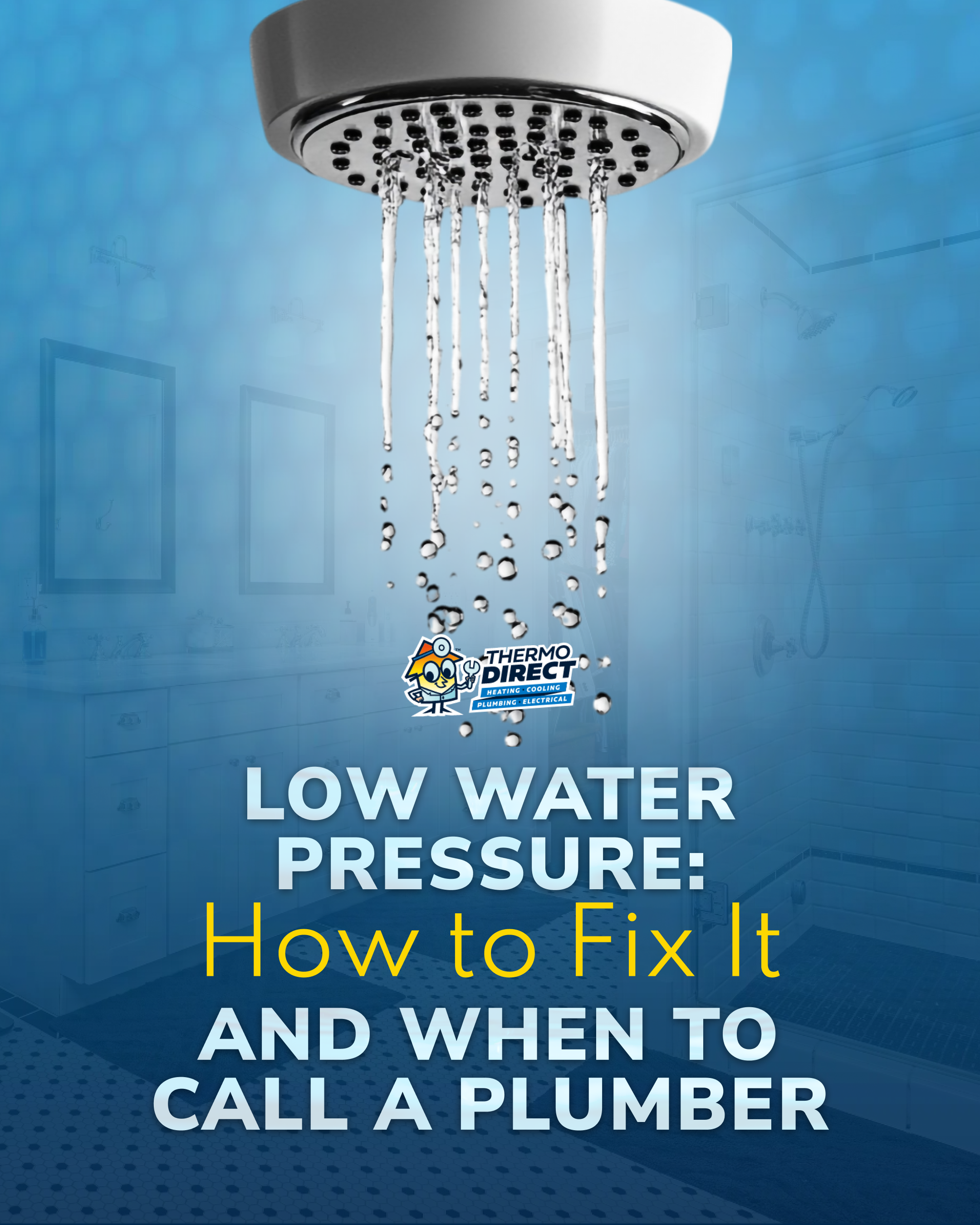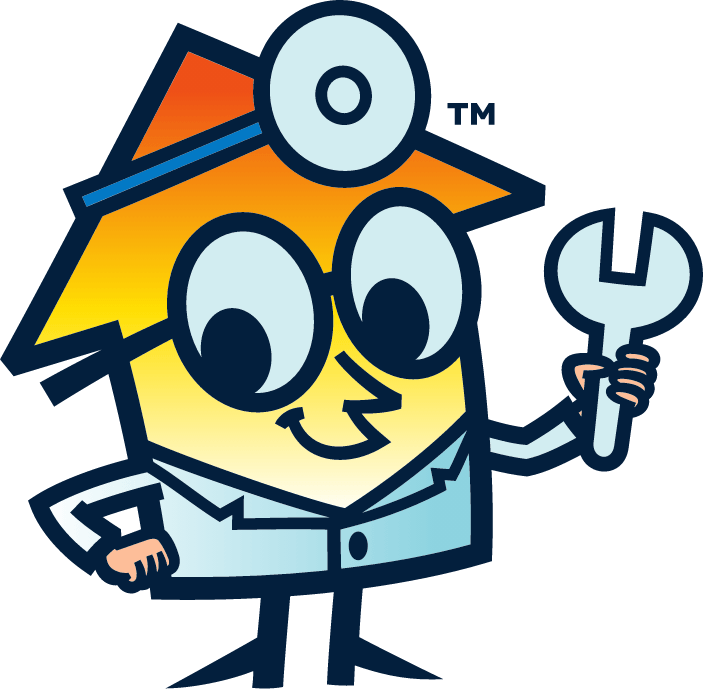Nothing is as irritating as losing water pressure mid-shower, except maybe experiencing low pressure when you’re watering the garden or hosing off your back porch.
If any of that happens, take a breath, remove the soap from your eyes, and contact Thermo Direct, Chapel Hill’s and Raleigh’s local water pressure experts.
What Causes Low Water Pressure in a Home?
Sediment buildup is often at the heart of water pressure problems — but not always.
Common causes of low water pressure
There are several other possible reasons for weak water flow:
- Clogged or corroded pipes: Rust, sediment, and mineral deposits can reduce or stop water flow.
- Clogged or faulty fixtures: If the water pressure is low in just one faucet, the aerator could be clogged. The same can happen to a showerhead.
- Leaking pipes: The smallest leak anywhere in the system can reduce water pressure over time — stains, mold, and foul smells can be signs of a hidden leak.
- Faulty pressure regulator: Sediment and corrosion can build up inside your pressure regulator, making it less efficient.
- Water heater problems: Sediment buildup in the tank can affect the pressure of your hot water supply.
- Partially closed valves: Shut-off valves can become corroded or gummed up with minerals, causing them to partially close.
- Water supply issues: When Raleigh adjusts or replaces pipes, it can disrupt the local water supply. If you and your neighbors experience severe backups, smell gas, or see discolored water, check with your water provider.
- Increased water demand: A sudden spike in water usage in your area can reduce water pressure.
- Water heater issues with hot water: The problem may involve a faulty thermostat, a damaged heating element, a broken temperature relief valve, a disruption in the power or fuel supply, or simply a high demand for hot water.
Sudden vs. gradual water pressure drops
A gradual reduction in water pressure is often caused by sediment buildup or a small leak in your plumbing. A burst pipe, a leak in the water main, a malfunctioning regulator, or a sudden increase in water demand can cause a sudden drop in water pressure. Generally, a gradual decrease indicates a long-term issue, while a sudden drop indicates a more recent problem.
Signs of a serious problem
These are signs you may have a more serious problem on your hands:
- Multiple fixtures with low water pressure: This often indicates you have a major break or leak in your plumbing.
- Multiple drains with standing water: This could mean a pipe is damaged or there’s a major clog.
- Discolored or rusty water: If the water coming from your fixtures isn’t clear, you have sediment in your pipes.
- Odors: If you smell unusual odors, it could mean foreign substances, such as mold and bacteria, are in your system.
- Sounds coming from the pipes and drains: Gurgling and other sounds could mean air is trapped in your pipes.
- Water pooling and watermarks: Water pooling in your basement or watermarks on your home’s foundation indicates a serious problem.
- Increasing water bills: A sudden spike in your water bill could mean a serious leak.
How To Fix Low Water Pressure at Home: DIY Solutions
Don’t ignore home water pressure issues because they can lead to costly repairs like burst pipes or foundation damage. You can take some steps to fix low water pressure yourself.
Step-by-step troubleshooting guide
Learn how to increase water pressure with the following:
Step 1: Check all your fixtures to identify if the issue is isolated or widespread.
Step 2: With all your taps turned off, attach the gauge to an outside faucet, and be sure the connection is tight. Turn the faucet on full for a reading.
Step 3: Remove the faucet aerators and shower heads and soak them in white vinegar to remove mineral buildup.
Step 4: Inspect and adjust the pressure regulator, located where the main water line enters your home. Attach a water pressure gauge and adjust the regulator as needed.
Step 5: Turn off all the appliances that use water and take a reading using a water meter. Wait 15 minutes and check again. If the reading changes, you may have a leak.
Step 6: Turn off the water supply and power and flush your water heater. Attach a hose to the drain valve at the bottom of the tank. Run the hot water in one faucet and open the drain valve, watching for sediment as it drains. Drain until the water runs clear. Close the drain valve, turn the water on, allow the tank to fill, and turn the power on.
When To Call a Thermo Direct Plumber for Low Water Pressure Issues
Some water pressure problems can only be addressed by a professional plumber. Sometimes, the problem is clear, but other times, a trained expert can spot solutions you might not consider, like eco-friendly solutions. When that’s the case, call the experts at Thermo Direct.
Situations that require professional help
Unfortunately, serious and minor plumbing issues can look alike. An experienced Thermo Direct plumber knows the difference.
- Main water line issues: Thermo Direct has the expertise and proper equipment to address underground leaks or blocked pipes.
- Old or corroded pipes: An old pipe can be on the verge of collapse. Thermo Direct can restore water flow by repiping it.
- Pressure regulator replacement: If adjustments don’t work or there’s damage, it’s time for a new one.
- Municipal water supply issues: A Thermo Direct plumber can diagnose when to call the city.
How a plumber can fix your low water pressure
Thermo Direct has the plumbing expertise, specialized tools, and equipment to understand the problem and make the repairs quickly.
- Video camera inspection: Thermo Direct can diagnose pipe blockages using minimally invasive cameras.
- Hydro jetting: Water under high pressure can clear clogs without damaging pipes.
- Pipe repair and replacement: Thermo Direct uses state-of-the-art techniques and equipment to upgrade or replace old plumbing.
- Booster pump installation: Thermo Direct can install a booster pump to increase water pressure.
Fast, Reliable Low Water Pressure Repair in Raleigh
Thermo Direct has you covered if you’re dealing with low water pressure or any other plumbing issue. Our experienced and licensed plumbers serve Raleigh, Chapel Hill, and surrounding areas with fast response times and expert solutions. Instead of searching for “why is my water pressure low?” schedule an inspection today. We offer free estimates and 24/7 emergency plumbing services when you need help fast.
Frequently Asked Questions
Do you have financing options?
Yes, we have financing options and no credit options. You begin with our easy application, followed by a quick approval process. We work with multiple lenders to find the best option for you.
Do you offer discounts?
Yes, we offer coupons, discounts, and rebates. Discounts are available on a wide range of our services, not just plumbing. Visit our website to see what is currently available.
How do I prevent low water pressure in the future?
The best way to avoid low water pressure is to have a regular plumbing maintenance plan and schedule regular plumbing inspections from Thermo Direct.









